Agile SEO: Introduction, Principles, Implementation, and Strategy
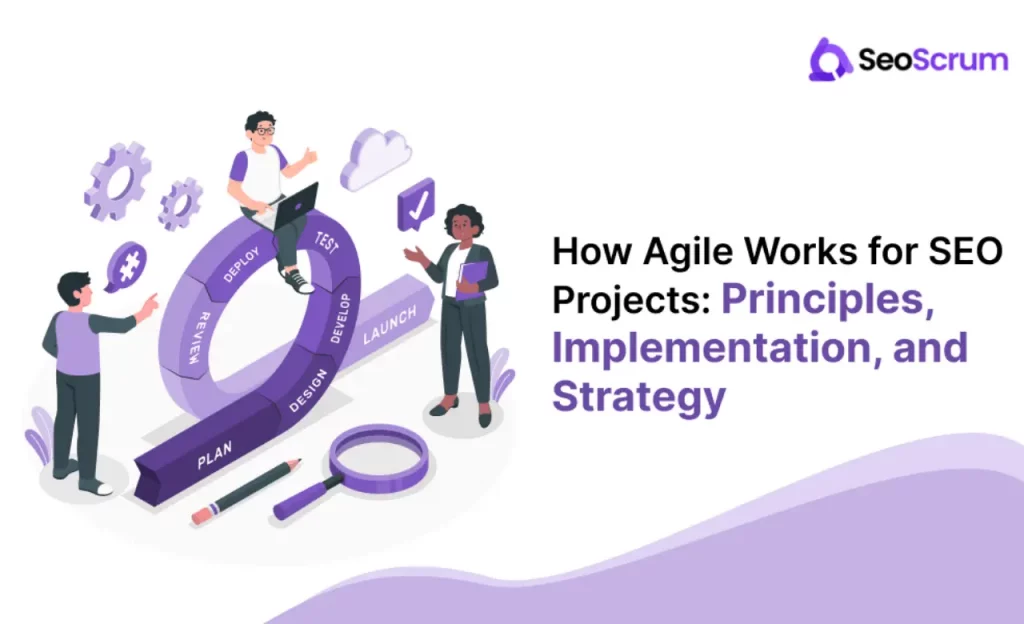
In this decade, the Global Digital Landscape is constantly evolving with new approaches, digital marketing trends, platforms, emerging competitors, and different techniques.
However, project management processes in their large volume failed to adapt to the changes occurring in this digital world. This article will delve into advanced management techniques through the Agile approach.
Are you the one who is surfing to improve SEO performance and manage those SEO projects efficiently? Have you been so far worried about the traditional linear approach to managing your work stuff wherein a detailed plan is crafted and all things are executed pre-determined, regardless of whether it is relevant or not?
It can be challenging to keep up with user behavior and search engine algorithms, yet there is a solution for this.
Introducing the Agile SEO approach which emphasizes flexibility, collaboration, and continuous improvement adds the solution. By applying Agile SEO principles to your strategy, you could respond more rapidly to all the changes in user behavior, search landscape, and prioritization based on user value and deliver outcomes faster.
And to have efficient work, an Agile SEO approach could help you.
Table of Contents
Why no Agile SEO adoption yet?
Agile is not an integral part of delivery. It’s a process of how you manage and review the project outcomes.
The agile method might not be applied directly by the companies due to some reasons such as their dynamic nature and ongoing process. Agile is used often with distinct iterations and phases while SEO needs continuous adjustments and monitoring.
Similarly, It heavily depends on data analysis for making informed decisions but Agile engages flexibility. Their Decisions must be grounded and might not benefit from quick changes which Agile often entails. The iterative approach of Agile may not align well with the patience required for outcomes.
This demands dynamic resource allocation to emerging challenges, wherein it must be scheduled within each SEO Sprint planning as well for specific tasks if following the Agile SEO approach.
How does Agile SEO make a difference?
The key point to adopting this agile SEO approach is that it has to strike a balance between the structured approach of Agile and the unique SEO characteristics.
While agile SEO may not be the primary framework, aspects of its methodology can be adapted to enhance its processes and management.
However, some elements of Agile SEO, such as collaboration, adaptability, and regular performance reviews, can be integrated into your strategy to improve efficiency and effectiveness.
To implement the Agile SEO approach, companies must develop
- Build cross-functional teams with expertise.
- Establish distinct communication channels.
- Use such frameworks as Scrum and Kanban.
- Embracing data-powered decision-making and analytics.
Even though based on the Agile SEO approach, with a lack of collaborative spirit, content, tech groups, and short-term goals of marketing aren’t aligned. Their efforts are allocated for every single phase they work on individually to bring off the results, their efforts ought to be unified to yield maximum outcomes from organic search. Moreover, implementing the Agile SEO approach is in-expensive.
In this perspective, managing keyword rank tracking, Keyword optimization, website structure changes, competitor research, link building, and so on, becomes easier and more convenient with an Agile SEO approach, breaking them into several small phases and prioritizing them.
Do you wish to manage it all more easily? The agile method takes to this plethora.
Path to incremental growth
Let us dig deeper to understand how this agile methodology could support changing the SEO game.
There are indeed several methodologies and techniques utilized for this. The essentiality to adapt, inspect, and get rid of waste of tasks to foster incremental growth constantly stands at the core of those approaches.
In incremental growth, you design the complete product first. You leave off the details which you could safely decide later.
Then you slice the project into small chunks and build every chunk separately. While you finish off the chunk, you integrate all the chunks with previously completed parts so they work as a whole. Pure incremental growth means replacing a single waterfall model with many, one for every module.
This is how you keep the build-up of defects in check periodically for every module. So that you will deliver flawless quality outcomes effectively.
Incorporating this with an agile approach leads to a reduction in costs and enhances the speed that yields better outcomes. Let us explore this in this blog.
What is Agile development?
I can define Agile development as more than just the capability of adapting to changes and technological development.
Agile methodology defines an approach that breaks down the projects into different dynamic phases, referred to commonly as sprints. An Agile Framework helps you to accomplish the iterative methodology.
Once every sprint is completed, the working people for the client reflect and look back at their work to see if any improvisation needs to be done so they can adjust their current strategy while doing the next sprint. They deploy and deliver the sprint by sprint.
The methods are extensively outlined in the Manifesto for the Agile approach. The entire process is intensified on major four beliefs.
- Individuals and Interactions must have control over the tools and processes
- Customer collaboration must be the central focus at all development stages.
- Responding to the change in the works better than following a plan rigidly.
- Documentation is not as significant as in a working client’s works.
The biggest difference between traditional processes and the agile approach is that the members were indulged even at the starting phase of the development process. The programmers address each problem instead of making various changes to the sprint at once after its launch.
The goal of this development is to constantly adjust your work in the developmental process, to craft a final portable product that necessitates very little changes.
Why do we perform Agile?
The word “Agile” means to move effectively, rapidly, and efficiently. But do you wonder if this same agile development can be used up for all works also? Yes! It can be. “Agile SEO” is a process or method to perform an SEO that is effective, efficient, and quick.
In any kind of agile development, the process or method must be repeated.
You have to get to know that Agile also has various methods and steps, so certain companies might vary in the way they execute Agile for their processes. The important thing in this scenario is that the process seems agile.
SEO is not the actual science, wherein it changes, evolves, and grows over time. Therefore, it is highly important to have a flexible strategy that assumes the constant evolution of it.
How does this agile SEO work?
It represents a dynamic approach towards Search engine Optimization, which emphasizes responsiveness and adaptability. It applies the agile method, to prioritize and execute all the works.
The primary goal is to deliver value to the user rapidly while continuously enhancing, adapting, and improving to evolution in Search engine algorithms and to give progress to user behaviour.
Get to know about the different vital principles of this approach listed.
- Prioritizing SEO tasks depends on the impact they cause and their importance.
- Breaking down the larger projects into manageable small ones.
- Regularly reviewing progress and adjusting if needed.
- Encouraging communication and collaboration among team members
Those principles are made through Scaling back the large ones like the backlink building or content optimization in the website to smaller actionable works. Those were then prioritized relying on the predicted influence on performance and its significance.
In this agile SEO, regular reviews were conducted to assess its progress and recommend any necessary strategic adjustments.
The approach is more responsive and adaptive to changing market conditions and frequently changing algorithms of Google than traditional ones. It prioritizes the value delivery to the user and engages continuous enhancement, to turn a more sensible approach in the ever-changing digital landscape.
Probably it thrives as a more dynamic approach to SEO with an immense emphasis on responsiveness and adaptability. The use of developing techniques and tools aids the business to grow online effectively by accurately measuring the current strategic success or not and tweaking on the fly.
While it might take a little time to see the outcomes, they do tend to come faster than the traditional approaches and deliver the advantages in the longer term, basically to build the platform for continuous growth in conversion rates, organic traffic, and rankings.
In today’s fast-evolving digital landscape, businesses can adopt agile SEO methods to stay competitive and constantly enhance online visibility, instead of employing the forget model. This consists of on-website work, like adopting the best practices on every webpage, and clearly defining the keyword goals.
Fine-tune the strategies accordingly
There are general seven steps of the agile cycle that everyone should know, use, and repeat the cycle for every phase of their work.
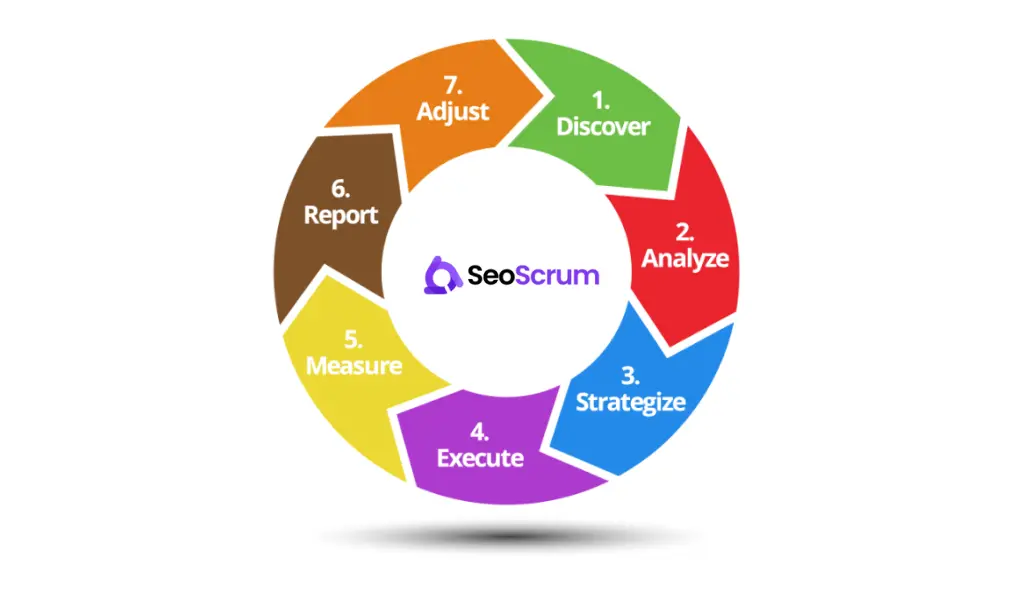
Image Source: https://mysiteauditor.com/blog/how-to-perform-agile-seo/
Discover
Before you commence, do an in-depth analysis with your client. Determine the purpose of your website. Pick out the primary conversion points, secondary conversion points, metrics, and events that the client defines as success.
Keep in mind that every client is different and varies in their requirements.
For example, the goal of your blog may be to get high traffic. The objective of a T-shirt company could be to acquire more e-commerce company sales.
Analyze
Review the entire website from an inside perspective and outside. Perform automated and manual content and site audits. Look thoroughly at site analytics and any marketing software that is installed on the site. Get to analyze and try to know the website entirely.
Strategize
Develop long-term and short-term plans for your work. What needs to be done to the website and the website landing pages for better optimization?
Identify how you are going to increase the authority of your website. Pick out the ways you are going to earn the shares and links.
Create a checklist for each single detail you have planned on the execution. Create the content calendars and do planning on the topics.
Execute
Commence to execute your strategy, laid out in the previous stage. Follow perfect planning and utilize the created checklist for your work in each SEO sprint, so that nothing slips out through the cracks.
Measure
Thoroughly have a good understanding of the impact of your campaigns. Seek out for the value. Do not underestimate your website metric value. Something very small matters a lot for your client on your site. So keep measuring everything.
Report
Communicate the impact of your outcomes very clearly and precisely to your client effectively and simply. Most significantly, do not forget to have communication about the value found in the previous step. Insist and remind the client why they want to pay you for their outcomes.
Adjust
Remember what Google conveys about SEO. You have to determine the campaign’s weaknesses and create strategic adjustments to enhance them. You have to pick out the campaign’s success and build on it.
Repeat the process.
Essential team for Agile strategy
Implementing Agile practices in your work essentially demands a cross-functional team having different expertise. By collaborative SEO work, while you adopt an agile approach, you could make a successful strategy driving more revenue and traffic from search engines.
The way you adapt the agile process for all your campaigns will be made convenient with SEOScrum, one of the top-rated best tool to enhance your website results and productivity. The tool manages each SEO sprint under this agile process and assists in ensuring dependable outcomes.
Through the Agile method and Scrum, Firms will be able to provide outcomes for their clients or indulge in their campaigns from competitors’ research to strategic outreach, technical audit, keyword research, copywriting, content audits, and much more.
The new strategies to manage your work are the utmost need for adaptation and inspection, reducing waste, and continuous progress. The key results of the agile SEO approach are that it enhances speed, minimizes costs, and boosts business outcomes. If any agency trying to adopt low cost SEO strategies, agile SEO would be the best choice.
Below are enlisted the roles of each member who are all involved in following the agile approach.
SEO Manager: While you have planned all your sprints, he oversees the entire strategy, manages the works, and makes sure periodically all your efforts are aligned with your business goals.
Those Managers are also referred to as traffic managers, in that they watch website performance for every sprint release ( ranks, CTR, impressions, etc.,). The manager also crafts and shares the necessary timelines for the initiatives and can hold accountability.
Content Strategist: Content Strategists are utterly responsible for developing a strong content strategy that aligns with your strategy targeting the perfect right keywords and offering immense value to your target audience.
Web Developer: The web Developer takes care of implementing all the technical best practices, such as improvising the structure of your website, crafting a mobile-friendly website, and optimizing website speed.
Analytics specialist: The analytics specialist volunteers to track and measure the outcomes of all initiatives in a single sprint, assessing data and offering insights.
UX Designer: UX Designer does the optimization of user experience of a website, such as layout functionality and navigation.
Copywriter: The role of copywriter stands out responsible for creating high-quality content and optimized content targeting the perfect keywords and giving a prominent value to your target audience.
Project Manager: He is the one who oversees the implementation of the initiatives, maintains timelines, and budgets, and makes sure all members indulged, work together efficiently.
SEO Executive: he/she is the primary evangelist of all the organic search efforts and he is the recipient of all reports and concentrates on the growth of strategy execution
Technical Lead: The Technical Lead monitors the problems that impact user experience and is highly responsible for the site being crawled and indexed by Search Engines.
SEO analyst: Makes data-driven decisions by planning tests, gathering data, and assessing the outcomes.
Product Team Member: He is the person who makes sure the optimizations and content for a specific product appear on the website.
Data Scientist: The Data Scientist acquires the advantage of assessing volumes of data to determine or estimate the patterns and trends for true data-driven decisions.
Related article: How to build SEO team structure?
Core principles of Agile SEO framework for projects
Agile framework typically has been increasingly popular in the SEO world because of its emphasis on collaboration, continuous improvement, and flexibility.
You can leverage the agile SEO framework on your tasks.
Iterative planning: Break down all your SEO strategy into achievable, smaller tasks referred to as “Sprints”, which typically last for 2-4 weeks.
This gives one to make quick adjustments based on feedback and data.
Prioritization: After your split up, look at and prioritize to work on the high-impact tasks aligning with your overall SEO goals, making sure to use the resources and time properly.
Collaboration: nurture open communication and teamwork among the SEO professionals, stakeholders, content creators, and clients on a regular basis.
Data-driven decision-making: Track and assess the performance with the associated SEO metrics continuously. Use this data to optimize your strategies accordingly and inform future sprints.
Flexibility: always be prepared to adapt your approach as per the project requirements based on competitor analysis, user behavior changes, and algorithm updates.
The popular agile frameworks for your SEO are listed below
Scrum: A popular framework consisting of short sprints, (generally 2 weeks), daily stand-up meetings, sprint reviews, and retrospectives.
Kanban: This is a visual project management system using boards and cards to represent works and their progress.
Scrumban: This represents a hybrid approach integrating elements of both Kanban and Scrum providing more flexibility.
By adopting this agile SEO framework, you could gain faster results for the projects, greater adaptability, perks up collaboration, and enhance the efficiency of all your SEO tasks.
Steps involved in creating an Agile strategy
It evolves as an iterative Search engine optimization method, consisting of different steps.
Step 1: Developing a result-oriented strategy
The first and foremost step in this agile SEO is developing a plan that outlines the goals, target audience, keyword, and the corresponding tactics. The strategy must be adaptable and flexible to the landscape change and user behavior changes.
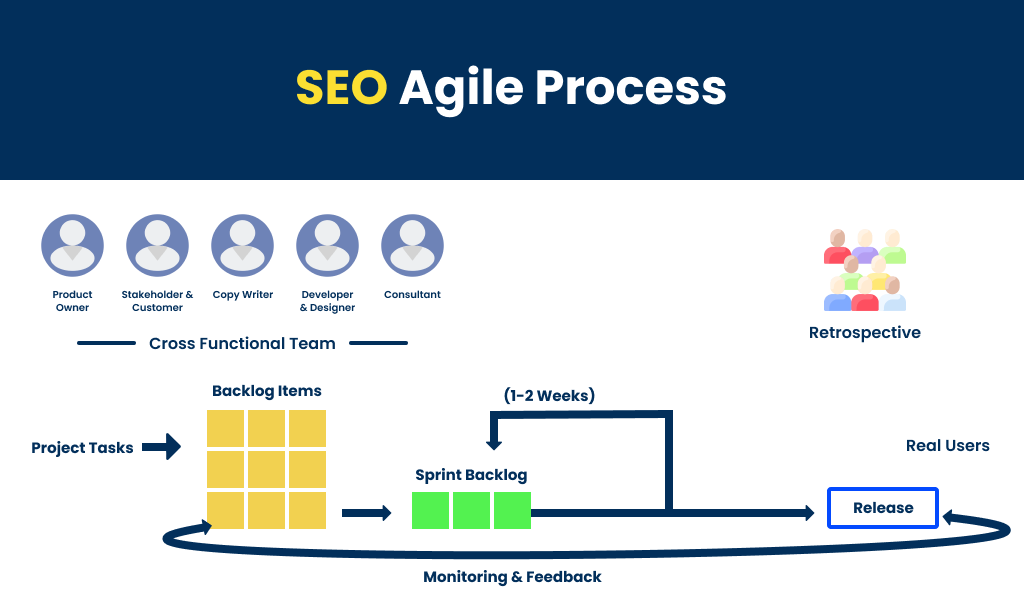
Step 2: Set clear goals and priorities
Defining your goals is the critical first step to implementing agile methodology. Prioritize your business goals based on the impact and importance of tasks.
For instance, if your website depends on local traffic, make priorities on the local SEO goals like improvising your Google My Business listing, website optimization for the local search queries, and making your site listed in the local directories.
Step 3: Create backlogs
Once you have set clear goals and priorities, create a backlog that includes both short-term and long-term tasks. Keep your backlog updated regularly as your priorities change.
Your backlog could include optimizing your meta descriptions, conducting keyword research, improving your website’s speed, and creating new content.
Step 4: Break down works into manageable smaller chunks
Once you fix the strategy in the perfect place, the next step to follow is the breaking down of works into manageable and smaller chunks which could be completed in iterations or short sprints. Again those, need to be prioritized depending on the business goals and impacts.
Breaking into smaller chunks could make the SEO sprints get prioritized, assigned, and move to completion faster.
If your backlog consists of optimizing your meta-description you can break this further into small chunks such as doing a review of your existing meta-description, determining unique opportunities for enhancement, and then a work on updating your meta-description single webpage at a time.
Step 5: Prioritize and assign tasks
Once you have done breaking down, prioritize their impact factor and then allocate them to the concerned members.
For instance, if your working member is a content strategist, you can assign all the content creation tasks to them while the technical tasks will be assigned to another person having more technical Expertise.
Step 6: Collaborate
One of the most significant challenges that the internal team faces is to implement an entirely collaborative approach toward digital marketing strategy.
The agile approach emphasizes collaboration among the team members and other departmental people like development and content. This collaboration supports making sure that all the tasks have been integrated into all website aspects and that those changes were implemented efficiently and rapidly.
Step 7: Test and measure
Measuring and testing the outcomes of your initiatives is a critical point in the Agile SEO framework.
Regularly measuring and testing the outcomes, businesses can decide to make data-driven decisions and constantly improve and refine their business strategies.
Step 8: Conduct regular reviews and adjustments
Regularly reviewing your progress and adjusting your backlog and priorities based on the feedback you receive is an essential element of agile methodology..
Let’s say you notice that your website’s speed is impacting your performance, You may need to adjust your backlog and prioritize improving website speed as a high-priority task.
Step 9: Assess and Adjust
Businesses must analyze the data and adjustments on the strategies according to every sprint in the agile methodology, depending on the measuring outcomes and testing outcomes.
This might indulge by becoming open to all the changes and making adaptations to any new information since it becomes available.
Step 10: Repeat
The final phase of the Agile SEO approach is in repeating the process. By continuously iterating upon strategy, testing results, measuring it and adjusting when needed, and assessing the data, businesses could halt competition and can pave more revenue and search traffic from search engines.
What are the agile principles and how to implement them in Agile SEO?
The four values of this Agile are the pillars of the method. From those values, the team developed 12 principles.
If the four values of Agile were the weight-bearing pillars of a house, then those twelve principles represent the rooms you could build in that house.
The principles you would adapt to your business to fit your demands.
Those twelve principles in this agile method were
- Satisfy the customer through continuous early improvement and delivery. When the customers get new updates, regularly, they’re highly likely to view the changes which they want from this product. This leads to more satisfied, happier customers and high recurring revenue.
- Welcome changing requirements, even if it is late. The Agile framework deals with adaptability. In this iterative Agile process, being to face inflexibility can cause more harm than good.
- Frequently Deliver the value: Similar to the first principle, delivering value to your site stakeholders or customers frequently makes it less likely to be converted to churn.
- Collaboration is key in this agile framework. The business goal is for the people to break out of their single project and make them collaborate altogether more frequently.
- Build among motivated individuals: Agile works best when the SEO is committed and working actively to achieve goals.
- The most efficient way to communicate is face-to-face. If you’re working on any distributed team, allocate and spend time and explore different ways which indulge face-to-face communication like Zoom calls.
- Working software is the primary progress measure. The most significant thing that must strive for in the agile method is the product. The goal here is to prioritize the functional SEO agency software.
- Maintain a sustainable working pace. Certain concepts of the agile method would be fast-paced, however, it must not be as rapid as team burnout. The objective here is to maintain the sustainability.
- Continuous Excellence improves agility. If the working crew develops an excellent code in a single sprint, it could continue to build the same in the next.
- Sequentially building great works allows them to move and grow faster going forward.
- Simplicity is essential. The common and simple solution is the best. The agile framework focuses on not overcomplicating things and gathers simple answers to complex issues.
- A self-organizing team yields good value. Like the fifth principle, a proactive team turns out valuable assets to your business since they strive to deliver good value.
- Regularly adjust and reflect on your approach to work to boost work effectiveness. Retrospective meetings were the general agile practices. It will be the dedicated time to have a look back at the sprints, reflect on the work performance, and adapt the behavior for future demands.
While I can’t directly implement the Agile method for your SEO projects, I can offer a detailed guide and key considerations to help you do it yourself! Here’s a breakdown:
Implementing Agile SEO methodology: A step-by-step procedure
The steps to implement the Agile SEO methodology and keeping the core principles in mind, you can effectively go on with this approach to achieve sustained success in the ever-changing search landscape. The steps indulged are
Kickoff Team meeting and planning
Gather your SEO team, involving content creators, relevant stakeholders, clients, and other SEO specialists.
After you gather the team, outline the overall SEO objectives clearly like to increase search traffic, improve keyword rankings, and more.
Audit your site, existing SEO efforts, and keyword performance.
After you analyze your current state, choose the specific agile framework based on the team structure, and project size.
Define and establish measurable and successful KPIs like keyword rankings, organic traffic, and conversion for tracking progress.
Backlog management and prioritization
Identify all your SEO tasks and brainstorm all the necessary works like content creation, on-page optimization, keyword research, and backlink building to create the final SEO backlogs.
Use the effort matrix or impact matrix, and prioritize the tasks based on the potential effect on the project goals and the required efforts from the team.
After you prioritize and work on, list all the prioritized tasks in backlinks, continually adding on the new tasks as needed.
Sprints management and Task management
Start the 2-week sprint and you set the sprint length, based on the team velocity and task complexity.
Plan each sprint, by choosing the high-impacting tasks from backlog. Break down the sprints into achievable steps.
Assign particular tasks to the team members with clear plans and deadlines.
Use an Agile project management tool to help you in tracking data, manage communication, and visualize workflow.
Collaboration and daily stand-up meetings
Every day, the team members must share the progress, pick out roadblocks, and collaborate on solutions.
Forge a collaborative environment where discussion and feedback are encouraged.
Sprint Review and Retrospective Phase
At the end of every sprint, evaluate the finished tasks, assess the data within the team and clients, and collect feedback from the stakeholders.
Determine the improvement areas in the SEO process, tools used by the team, and the entire strategy.
Based on the review phase and retrospective in agile SEO methodology, clearly refine your approach for the next sprint.
Benefits of Agile SEO
Agile strategies work as they prioritize collaboration, continuous progress, and flexibility which are essential in the fast-paced digital landscape of today.
Below are the reasons to show why the Agile method were effective.
Flexibility: The Strategies were designed as adaptable and flexible to differing circumstances such as changes in user behavior or search algorithms. This makes the business respond rapidly and make adjustments in the business changes at each sprint.
Collaboration: Agile SEO strategies encourage and engage collaboration. This would lead to more integrated and effective outcomes.
Focus on customers: It concentrates on the demands of customers instead of search engines alone. By creating high-quality content and site optimization for user experience, the businesses could uplift their rankings and it paves the way for more revenue and traffic from search engines.
Continuous progress: The strategies emphasize the significance of regular test processes and measuring outcomes that lead to refining strategies and constant improvement.
Better Return on Investment: By progressively refining and optimizing those strategies based on feedback and data, the approach could aid in enhancing the ROI of initiatives.
Overall, It works as they give precise priority to flexibility, continuous progress, and collaboration, essential in this decade. Businesses could stay competitive in search engines and gain more revenue and traffic from search engines.
Monthly agile SEO process
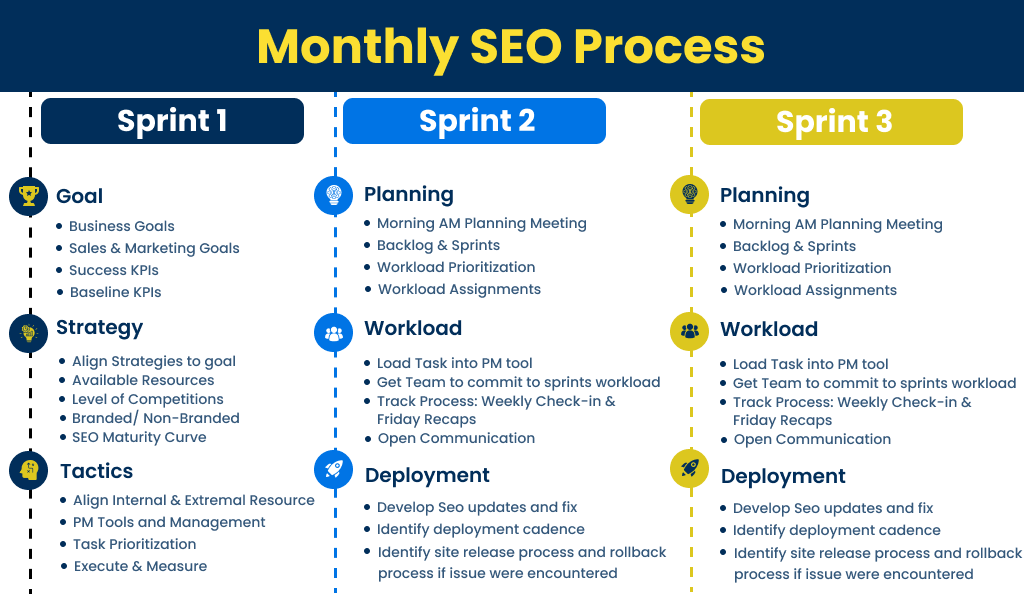
Scrum
Scrum is the general agile method for all small teams and it consists of Sprints. It will be led by a Scrum Master, whose major job will be to clear out all the obstacles and execute the daily work.
In the Scrum method, you will have discussions daily about their roadblocks, active works, and others that might impact the development of each sprint.
Sprint Planning: The planning of sprints, and events is the initial stage where the sprint is kicked off. Sprint planning outlines what could be delivered in a single sprint and how.
Sprint Retrospective: This is the recurring meeting that acts as the review for a sprint for iterating on the sprint learning from the past sprint that would enhance and streamline the next sprint.
Organize Agile processes with SEOScrum
Any team at any time can run agile. If you are looking for a highly flexible project management framework, then try out Agile SEO, and manage all your tasks through the Scrum Method with our SEOScrum.
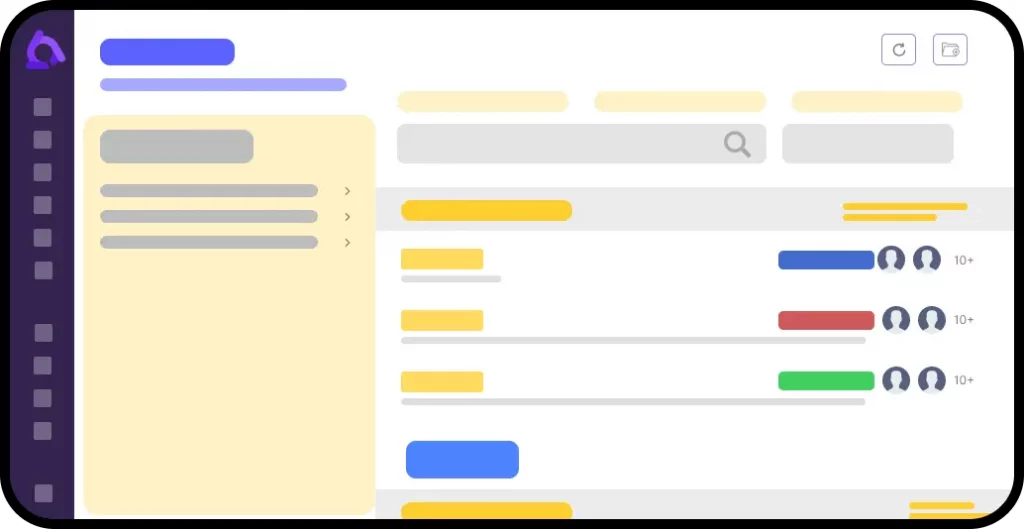
It is an efficient SEO management software with Scrum-based method.
Examples and implementation of how this Agile SEO works.
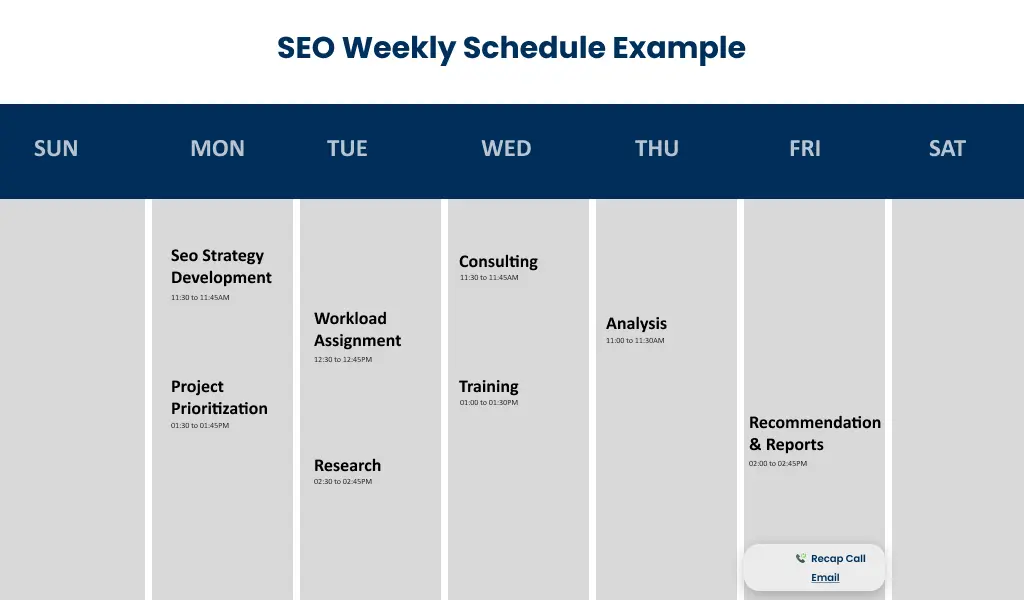
First off, let us take a comprehensive look at the traditional method.
If you wish to overhaul your tasks, the widened strokes of all the plans look like this.
Checking for any Website’s Technical Errors such as 404 error, responsiveness, broken links, other redirects, and so on.
- Optimization of title tags and the meta-description of every webpage.
- (Re)Optimize the existing content like the blog posts and webpages.
- Create a peculiar editorial calendar for your sprints and commence crafting new content.
- Searching for any link opportunities like guest posts and so on.
So all those tasks are a bit too much to tackle within a month, couldn’t you say?
In this traditional approach, you could commence working on all the items at the same time.
It is not impossible, specifically as you need people with different skills on board. If your web developer can fix all the technical issues, your content developer crew could create Meta descriptions and be involved in preparing the editorial calendar for each sprint or all.
But here comes the thing, the agile method proffers you the chance to fuel your business strategy with outcomes from each of your sprints.
Challenges of Agile SEO
Metrics and Measurement: Traditional Agile metrics may not directly translate to SEO. define the appropriate KPIs and tracking data is critical.
Collaboration and communication: Implementing Agile requires seamless collaboration between various teams (SEO, content, development, etc.). This can be tricky, especially in organizations with siloed structures. Clear communication and transparent workflow are crucial.
Technical limitations: Implementing the SEO changes may require development time, which slows down the sprints. Agile processes ought to account for the dependencies.
Team Buy-in: Not everyone will be familiar with the Agile principles. So educating the team and making sure the team’s buy-in is highly essential for successful implementation.
Short-term versus Long-term: when Agile excels at quicker iterations, certain SEO strategies may need long-term commitments for instance building backlinks. So balancing both perspectives is more important.
Data analysis and interpretation: Understanding and interpreting the SEO data requires expertise for informing sprint decisions. So investing in data analysis skills or software is more crucial.
Scope creep: Prioritization thrives as a key in Agile, however, it’s tempting to add new tasks during sprints. Sticking to managing expectations and prioritized tasks is crucial.
By acknowledging the challenges of agile SEO and employing the potential strategies, you could navigate the hurdles and reap the Agile SEO rewards, driving the sustained enhancement in the online visibility and success path of your site.
To overcome the challenges of agile SEO, initially start with a pilot SEO project and then gradually expand. Focus on the selected metrics coping with your SEO. set expectations, encourage open communication, and hold regular meetings across teams.
Ensure everyone is aware and understands the Agile principles and its process in SEO tasks clearly.
Invest in training and tools to efficiently interpret SEO data for decision-making.
Agile SEO approach in executing SEO plans
Cross checking and fixing the technical errors
Before moving to step two have a closer look at the outcomes. Measure your site KPIs. Do any of your tasks work out? Does it anyway improve your rankings? Put together all as a report and get buy-in for all the next phases.
Optimize the tags and the description.
It’s not necessary to do this optimization for the whole website, rather you can do it for the most important web pages.
Again, check out the results. You must be able to view the increase in the website’s organic traffic.
You may also note the increase in business sales. The increase in sales could aid in financing the below steps.
By the time you get to publish what is written in the editorial calendar, you may gain a solid base for building it. In the best way, while you are looking out for any outbound linking opportunities, you will have a great website to show off.
One significant thing to denote here: you should not think about publishing the content as one sprint. This is a marathon. Content sprints involve multiple stages to write and discover high-performing content.
Treat every piece of post as a single sprint only. Test, Measure, and make comparisons. Check out what works for your business and what doesn’t work for you…
High rankings are not the goal always. Neither is organic traffic.
Each step of your strategy must be performed to support your business goals. The agile approach seems ideal for the keywords also, the clients may come to get the results for efforts approaching with a high list of keywords which they wish to rank for.
They Know that this SEO takes time, hence they wish content for as many of them as possible. And yes, it could be accomplished. You could dump 30 articles on your post in a single day. However, do you know why no one recognizes this? Because it is a waste.
When you publish gradually, you give the web pages time to get crawled by the search engines. And even this is picked up by the other bloggers and linked to. You have all the time you ought to focus on inbound linking. Posting gradually paves your new post to capitalize on the SEO juices of others. The regular polishing schedule is the one that Google appreciates the most. This happens for each sprint also in the agile approach
Agile SEO vs Traditional SEO
Agile SEO stands out for its adaptability and iterative nature, enabling teams to swiftly respond to market changes and algorithm updates through short, focused sprints.
This approach promotes continuous testing, optimization, and a collaborative team environment, where feedback is rapidly incorporated into strategies. Agile SEO’s flexibility makes it ideal for projects requiring quick adjustments and frequent reassessment of goals based on real-time data.
Conversely, Traditional SEO follows a linear, structured process akin to the waterfall model, emphasizing detailed planning, execution, and analysis in sequential phases.
This method suits projects with well-defined objectives and timelines, where comprehensive keyword research and competitive analysis are crucial. Although it offers predictability and thoroughness, Traditional SEO’s rigidity may limit responsiveness to sudden market shifts.
As the SEO landscape continues to evolve, understanding the nuances of Agile SEO vs Traditional SEO is crucial for agencies aiming to enhance their online visibility and achieve sustainable growth.
Bottom line
As Search engine Optimization is constantly changing, their Campaigns ought to be currently updated with the best practices and keep on this track. It is where the agile approach lends its strengths.
When adopting SEO, and implementing this Agile SEO approach, you must focus on one aspect of your Campaign at a time and make it work perfectly before you move to the next sprint. This process will be effective and accommodate the constant change within processes.
A SEO project management software like SEOScrum is dedicated to providing efficient and professional agile solutions, and using this service eliminates the hassle of independently managing tasks. This would guarantee that your efforts will remain true and relevant to your original business goals.
After the implementation of Agile SEO for your own business, and for any client requirements, I can say the two things about it which I will appreciate the most are the visibility and flexibility.
This agile SEO approach offers you the time to fine-tune everything as you traverse. You do not need to craft a massive volume of content for your website at once or to re-optimize it.
By using this sort of perfect Agile SEO product and technology it streamlines your workflows, fostering efficient collaboration and communication among the stakeholders and working group.
You can adjust your strategy for every sprint whenever required for your goal and manage SEO projects step by step. You’ll be able to remain ahead of staying competitive, gain high-performing results, and drive high organic traffic to your website. So why are you still waiting? Start employing the Agile SEO approach into practice today and watch your Search Engine Rankings soar!!

